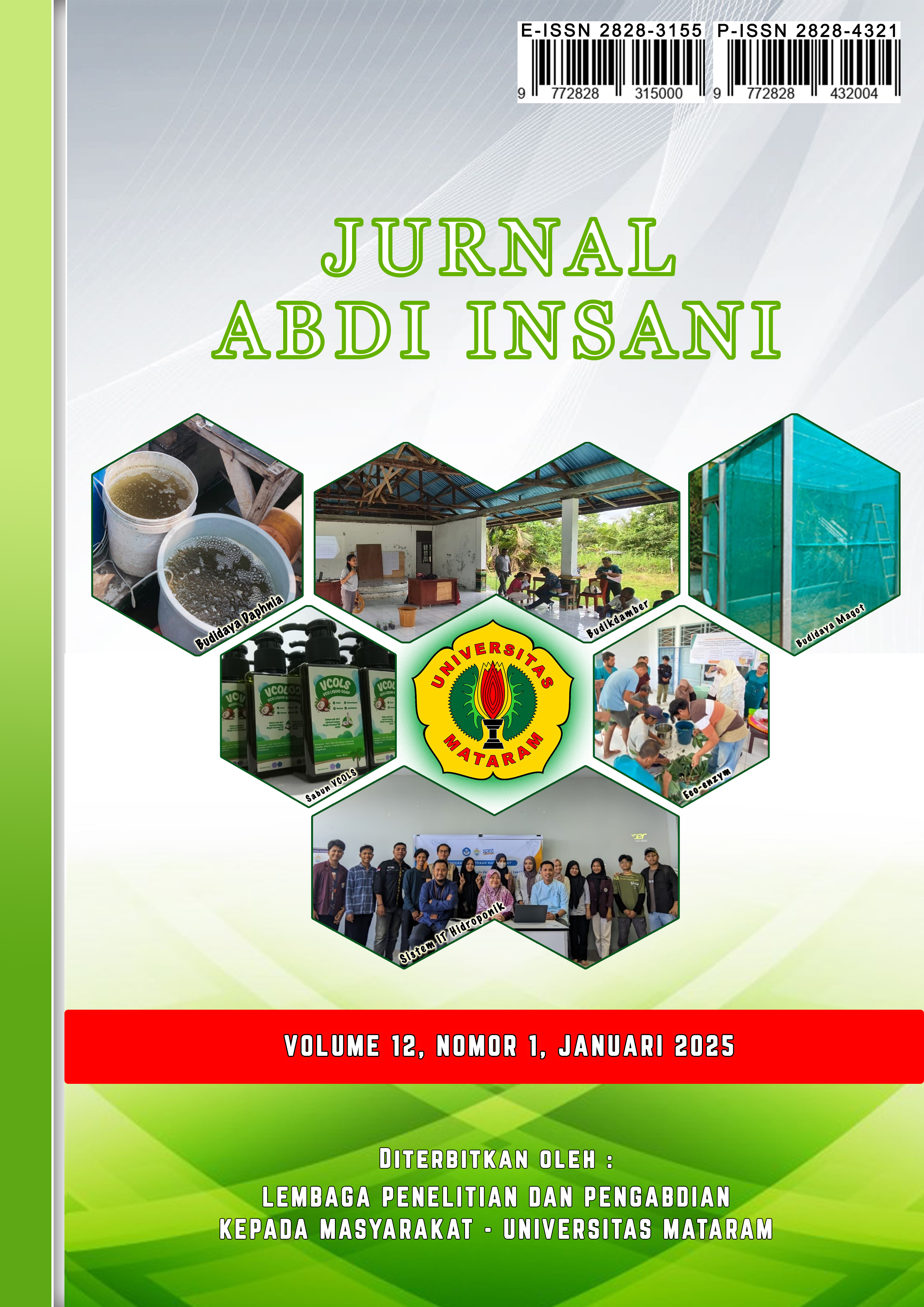SENAM ERGONOMI UNTUK PENCEGAHAN LOW BACK PAIN PADA PELAJAR SEKOLAH MENENGAH KEJURUAN DI SURAKARTA
DOI:
https://doi.org/10.29303/abdiinsani.v12i1.2177Keywords:
Ergonomic, Work Posture, Musculoskeletal Disorders, Exercise ErgonomicAbstract
Vocational High School is one of the vocational education that organizes education to prepare the next generation who are skilled in the industrial field. Activities at Vocational High Schools are more practical activities in workshops or laboratories. It is very important to introduce occupational safety and health to students so that they are able to recognize potential hazards in the workshop or laboratory. Based on an initial survey at the State Vocational High School 2 Surakarta, it has a machine laboratory which has lathe, milling, grinding, welding machine, and technical drawing facilities. The results of the initial survey focused on potential ergonomic hazards, because the results of observations on students who use equipment or machines in the laboratory do excessive muscle loading such as bending, twisting, neck flexion>200 and static foot positions so that potential musculoskeletal disorders can occur. So the purpose of the community service activity is to measure work posture to see the risk of musculoskeletal disorders and perform ergonomic exercises as a means of stretching muscles that experience loading. This community service activity runs with 2 methods, namely the Measurement Method and the exercise Method. The measurement method is anthropometric measurements used to determine the suitability of body posture with the dimensions of work equipment, so that these measurements can be used as a reference for the acceptance of SMKN 2 Surakarta students, especially in the aspect of height requirements. REBA measurement is a measurement of work posture that focuses on the upper body and lower body, such as the neck, shoulders, upper arms, and legs, so that we can see a picture of ergonomic risk factors in students majoring in machinery at SMKN 2 Surakarta. Nordic Body Map measurements are used to determine the level of musculoskeletal disorders. Activities in the laboratory of SMKN 2 Surakarta that have the risk of unnatural work postures have an impact on the occurrence of MSDs complaints. Exercise method, where the potential ergonomic risks are medium and high categories, it is necessary to take action to help reduce these potential hazards, one of which is by doing ergonomic gymnastics. This exercise model is made based on observations and measurements of potential ergonomic hazards, especially looking at body parts that experience unnatural work postures and static loading, so that this exercise model can be used as a way to reduce the risk of MSDs. Ergonomic gymnastics activities can be an alternative to reduce complaints of musculoskeletal disorders. The conclusion of community service activities is that activities in the lathe and technical drawing laboratories have high ergonomic risks and milling and grinding machines have moderate ergonomic risks so that ergonomic exercises can be applied before doing activities using machines or learning pauses for 5-10 minutes.
Downloads
References
Agung, et al., (2018). Hubungan masa kerja, posisi kerja, dan indeks massa tubuh dengan kejadian low back pain pada tenaga kerja bongkar muat. Universitas Muhammadiyah: Semarang.
Alfiani, L., & Basri, S. (2016). IMT dan masa kerja terhadap keluhan nyeri punggung bawah pada buruh panggul. Jurnal Kesehatan Masyarakat, 1(4), 35–40.
Health and Safety Authority. 2015. Manual handling infographics [Online]. Dublin: Health and Safety Authority.
Health and Safety Executive. 2015. Work-related musculoskeletal disorder (WRMSDs) statistics, Great Britain 2015 [Online]. London: Health and Safety Executive.
International Labour Organization. 2004. Keselamatan dan kesehatan kerja di Indonesia. Manila: International Labour Organization.
Kurniawidjaja, M. (2015). Teori dan aplikasi kesehatan kerja. Jakarta: Penerbit Universitas Indonesia.
Mallapiang, F., Azriful., Habibi, A., Aeni, S., & Ismawati, T. (2019). Analisis postur kerja dan re-desain fasilitas kerja pada pengrajin batu bata di Kelurahan Kalase’rena Kec. Bontonompo Kab. Gowa. Public Health Science Journal, 11(1), 49–59.
Nilamsari, N., Soebijanto, S. M., Lientje, S. M., & Setokoesoemo, B. R. (2015). Prototype bangku ergonomis untuk memperbaiki posisi duduk siswa SMAN di Kabupaten Gresik. Jurnal Ners, 10(1), 87–103.
Pradewi, I. T. (2018). Hubungan postur kerja dan beban kerja fisik dengan keluhan muskuloskeletal pada pekerja bagian ring spinning di PT Kusuma Putra Santosa Karanganyar. Surakarta: Fakultas Kedokteran Universitas Sebelas Maret.
Rivai, W. T., Ekawati., & Siswi, J. (2014). Hubungan tingkat risiko ergonomi dan masa kerja dengan keluhan muskuloskeletal pada pekerja pemecah batu. Jurnal Kesehatan Masyarakat, 2(3), 227–231.
Setyawan, F. E. B. (2011). Penerapan ergonomi dalam konsep kesehatan. Jurnal UMM, 7(14), 39–50.
Sholeha, N., & Sunaryo, M. (2022). Gambaran keluhan musculoskeletal disorders (MSDs). Jurnal Kesehatan Masyarakat (e-Journal), 10, 70–74.
Suma’mur, P. K. (2009). Higiene perusahaan dan keselamatan kerja. Jakarta: CV Sagung Seto.
Tarwaka, S., & Sudiajeng, S. (2004). Ergonomi untuk keselamatan, kesehatan kerja dan produktivitas. Edisi 1, Cetakan 1. Surakarta: UNIBA Press.
Tarwaka. (2015). Ergonomi industri, dasar-dasar pengetahuan ergonomi dan aplikasi di tempat kerja. Edisi 2. Surakarta: Harapan Press.
Umi, H. (2018). Pengaruh senam ergonomis terhadap penurunan tekanan darah pada lansia yang mengalami hipertensi [Skrips]. STIKes Insan Cendekia Medika, Jambong.
World Health Organization (WHO). 2014. Protecting workers' health. World Health Organization Fact Sheet No. 389.




















